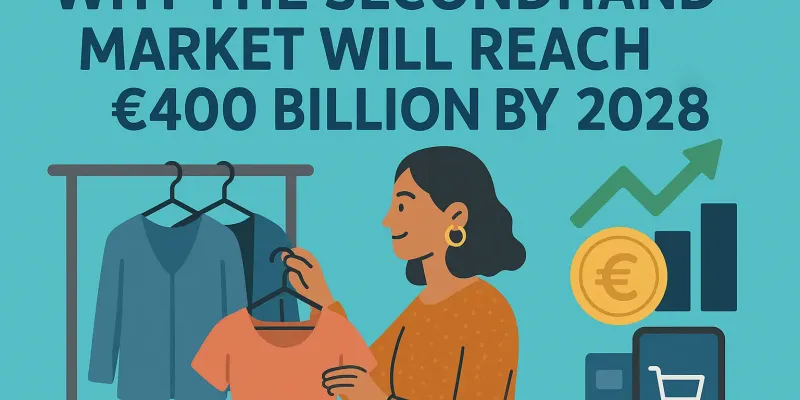The secondhand market isn’t just booming—it’s on the verge of a revolution. With projections placing the global secondhand apparel market at a staggering $350 billion–$367 billion (approx. €325–€340 billion) by 2028, and the broader used goods sector climbing even higher, the €400 billion milestone is within reach. But what’s fueling this rapid growth, and how can you ride the wave and profit from this circular economy megatrend?
The Growth Engines Behind the €400 Billion Surge
- Changing Consumer Mindsets: Sustainability isn’t optional anymore. Nearly half of consumers now cite environmental concerns as a reason to buy secondhand, especially among Millennials and Gen Z. Reducing waste and fighting overconsumption are everyday values—not just slogans.
- Economic Pressures: Persistently high inflation and tighter consumer budgets are pushing shoppers towards affordable, pre-owned options in all sectors, from fashion and furniture to electronics and cars.
- **Digital Transformation: **Online resale platforms (eBay, Vinted, ThredUp) have made buying and selling used goods easier and safer than ever. Technology is also enabling dynamic pricing, AI-powered authentication (for luxury goods), and even blockchain transparency to guarantee trust.
- Brand Adoption: Major brands now launch dedicated resale programs (think Patagonia, Levi’s, IKEA), recognizing resale as a new profit center instead of a threat. This widens the secondhand customer base by mixing new and used inventory.
Market Stats and Projections
| Category | Projected Market Size 2028 | CAGR (2025-2028) |
|---|---|---|
| Global apparel resale | $350B (€325B) | 12–14.9% |
| Total used goods market | ~$1T by 2035 | 17.2% |
| European secondhand | €86B by 2028 | 22% |
| U.S. secondhand apparel | $73B by 2028 | 11% |
By 2028, it is likely that the value of all secondhand goods—including fashion, electronics, furniture, autos, and luxury—will top €400 billion worldwide, propelled by rapid growth across every category and region.
How To Profit from the Secondhand Boom
1. Start Selling (Even Small-Scale)
- Pick your niche: Fashion (clothes, shoes, accessories), tech gadgets, luxury bags, collectibles, furniture.
- Source inventory: Curate from your home, thrift stores, auctions, or dedicated wholesalers.
- Choose platforms: Local markets, eBay, Vinted, Facebook Marketplace, The RealReal (for luxury). Some companies (ThredUp, Vestiaire Collective) even send you bags for easy resale.
2. Build a Resale Business
- Stand out for quality: Success favors those who curate high-quality, authentic items. Reputation is key.
- Go omnichannel: Use a blend of markets, pop-up shops, and online channels to reach more customers.
- Optimize pricing: Price items at 25–40% of original retail, leaving room for negotiation. Adjust for season and track competitor listings.
- Invest in tech: Use inventory tools, dynamic pricing software, and authentication services for luxury.
3. White-Label and Brand Partnerships
- Launch your own resale program: If you run a retail business or brand, introducing trade-in and buy-back schemes can win new customers and boost loyalty.
- Work with platforms: Many resale brands now partner with independent sellers, offering tools for logistics and customer service.
4. Ride the Circular Economy Wave
- Refurbish and upcycle: Sectors like electronics and furniture thrive on certified refurbished goods.
- Embrace repair and customization: The demand for repair services, alterations, and bespoke upgrades is rising, too.
5. Harness Trends
- Watch Gen Z: Younger buyers are increasingly shopping secondhand online—especially in fashion and luxury.
- Eco branding: Highlight your sustainable credentials to attract conscious consumers.
The Bottom Line
The secondhand market’s march to €400 billion is unstoppable, fueled by sustainability, economics, and digitization. Whether you’re looking to clear space and earn extra cash or scale up into a re-commerce enterprise, the playing field has never been more open. Choose your approach, prioritize quality and trust, and get started—the future of retail is secondhand, and the next wave of profit is already here.

